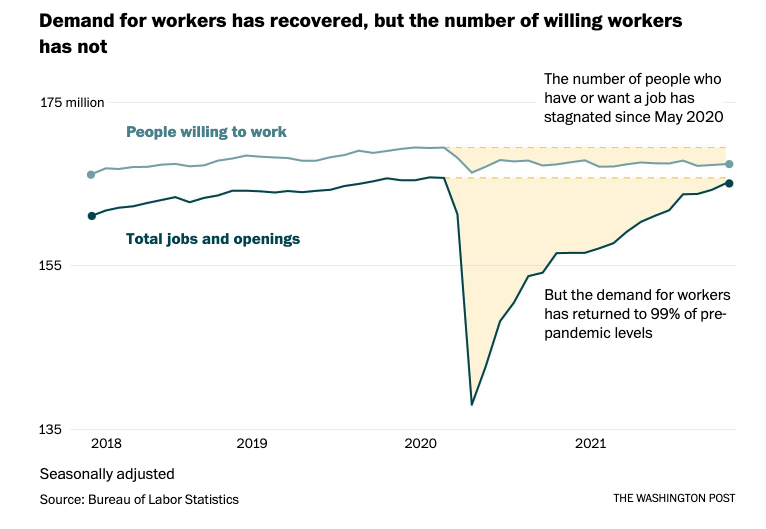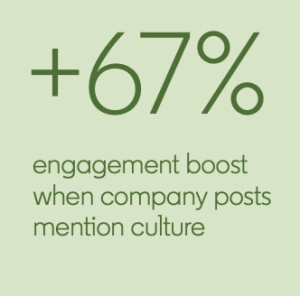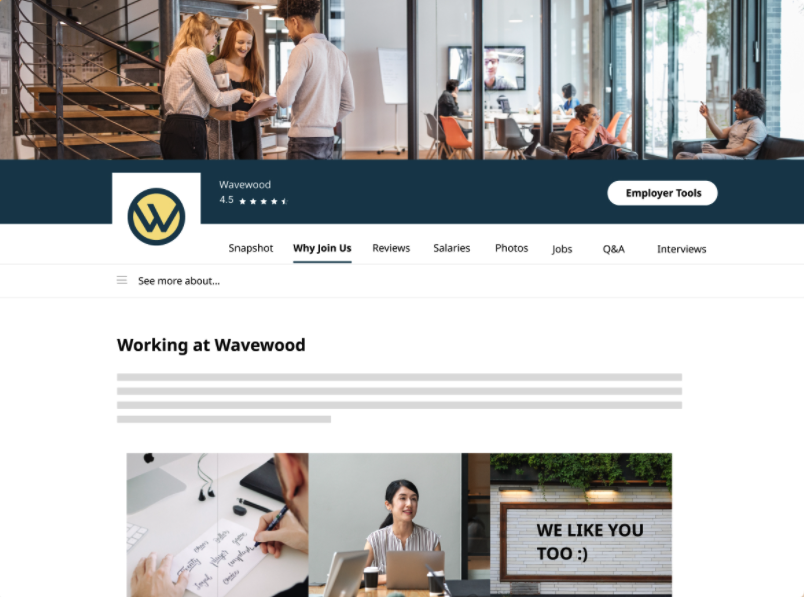A recruitment marketing strategy isn’t just for talent search agencies and headhunters. It’s a vital necessity for small businesses.
Employees have quickly become scarce for many industries in this volatile labor market.
And tech companies have known this for a while. When programmers become available, for example, head hunters are on ‘em like a cheetah on a gazelle.
If you’re not out there hunting, too, you could be stuck gnawing on bones.
And here’s another reality…the “difference maker” employees aren’t unemployed…or really looking for jobs. If they’re good, they already have a job.
You’ll want to be on their radar when they’re ready for their next move.
Why recruitment marketing?
It can sometimes be tempting to maintain the status quo, right?
It’s a hassle to (and sometimes expensive) to craft help wanted ads, post them, invest time for interviews, blah blah blah.
Just one more thing on your plate.
But…(and here’s where you get into second level thinking) invest in the right people and you actually save time and money.
You can find people who don’t need to be micromanaged.
They care about solving problems…in fact, they thrive on it!
Now you can really scale your business because the right employees are assets…they provide more value than they cost. (As long as you create the right kind of environment…but more on that in a bit!)
Sound good?
So let’s get into it!
So why do you need the right recruitment marketing strategy right now?
This graphic from a recent Washington Post article says it all:

With diminishing numbers of willing workers, attracting and keeping quality employees becomes even more critical. And doing so requires more than marketing tactics, effective talent acquisition, or compelling job ads.
For example, you may have a world-class career site for attracting potential candidates, but if people are leaving at a faster rate than you’re hiring, you’ll be winning a race to the bottom.
There are two significant reasons to get started now. First, unemployment is at a 50 year low. There are simply more jobs available than there are employees.
Second, developing your recruitment marketing strategy will give you a head start in a very competitive race. Unfortunately, most small businesses are still struggling to come to grips with the problem. Most see it as a hiring challenge rather than a marketing challenge.
But without effective recruitment marketing, you won’t be hiring the folks you need in a job climate like this one.
The big corporations have been playing the game for a while now, but small businesses often can’t afford to outsource recruitment marketing efforts, and probably shouldn’t. However, your business marketing team can help your hiring team get up to speed.
Where to start with your recruitment marketing strategy
We will outline a very basic plan and a few tactics to get you started.
The first task is to align your employer brand with your company brand. The overall success of your recruitment marketing strategy and the long term success of your company depends on this first principle:
Create the kind of company people want to work for, and you’ll become the kind of company your clients want to do business with.
Attract the kinds of employees that relate with your customers.
Great company cultures aren’t built overnight, and there’s always room for improvement. Now’s the time to examine and close the gaps between the culture you aspire to and the current reality.
Doing so doesn’t just make for good marketing. It makes good business sense.
And it doesn’t have to mean rebuilding a company culture from the ground up. First, begin by asking yourself what employees really want.
The LinkedIn Global Talent Trends report (LIGTT) provides excellent findings to guide your answers and apply them to your company.
Empathy is key to a healthy, marketable culture.
All great marketing and culture-building begin with empathy. It’s the hallmark quality for influencing your client’s and employees’ mental, emotional, physical, and financial well-being.
Here’s a statistic worth considering from the LFTT:

LinkedIn Global Talent Trends Report
Millennials are now the largest generation in the labor force. And they’re keeping it real in the workplace.
They want to know prospective employers are creating and nurturing an engaging company culture or just building a money machine.
Money is not their first priority.
Just ask Simon Sinek. They want free food and beanbags, but still aren’t happy.
So, how can you demonstrate and go public with your commitment to a culture that keeps it real?
Consider the Big 3
When it comes right down to it, most people are happy when they:
- have a degree of control over their environment
- can make a positive impact
- live out the lifestyle that suits them.
For some, that might mean having control over how they manage their customer accounts, seeing positive growth from those accounts, and being able to come into work later, take a longer lunch break, but then work into the evening.
Of course, this needs to fit into the needs of your business, but seeking ways to accomplish the Big 3 increases employee happy dances.
Which increases customer happy dances.
When in doubt, ask.
Start by spending a lot of time asking questions and listening intently to the answers.
The aim is to persuade employees to buy into the current strategy and vision and to have senior leaders tuned in to what employees want. And having those wants influence your company’s vision for the future.
Do this well, and you’ll have a great story to tell prospective employees.
Consider what the job candidate’s current experience. And spend some time imagining what that first encounter should look like.
For example, typical onboarding is considered an opportunity for the employer to show and tell.
But let’s face it, many of those experiences result in soul-crushing boredom. (“Here’s our company handbook, fill out these employee info forms, be sure to park 6.3 meters from the dumpster…”)
Doesn’t really inspire creative energy does it?
Instead, find creative ways to make the process engaging and interactive.
For example, the tech company Square includes informal 1:1 coffee chats between new hires and senior management as part of its onboarding process.
Coffee or soul-crushing boredom…which would you prefer?
Easy on the aspirational stuff
A word of caution when it comes to your strategy and how you portray your company culture:
Today’s job seekers are savvier than ever.
Just as your business customers research your service or product before they get in touch, so with job seekers, it’s better to surprise them on the upside than the downside with your company’s introduction video, for example.
Paul Wills, Senior Director at Wicresoft, says that one of the biggest mistakes he sees is employers trying to paint an idyllic picture of the work environment.
“The average job seeker see right through the aspirational veneer. It detracts from your brand, rather than enhancing it.”
Wills suggests you substitute the word “job” for the name of your product or service when marketing your company culture.
Finally, some tactical advice.
Although developing an engaging, desirable work culture is the single best thing you can do to market your company to prospective employees, it’s not enough in itself. You’ll also need a tactical approach for getting the word out.
Here’s Paul Wills’ punch list to get you started:
- Set up a referral program. Referrals may be your most reliable and essential source for finding employees. According to CareerBuilder, 88% of employers agree on this point.
- Day in the life videos. Create a short video that depicts the employee’s perspective and highlights an actual employee. You have this done professionally or use the latest iPhone to shoot footage.
- Perform a competitive analysis. Evaluate the job market and learn from your competitors. Play to your strengths.
- Respond quickly to interested prospects. It’s a way of demonstrating you value them early on. It also makes good sense from a tactical standpoint.
The most underutilized secret weapon
There’s a valuable piece of digital real estate that you may already own a piece of without knowing – an Indeed.com company page.

Indeed.com company page
Whether you need to claim your Indeed company page or create one (you’ll find out when you set up a profile), it’s worth developing and maintaining as a recruitment marketing outpost.
Final Thoughts
As the coach of your team, you need high caliber players to compete. And you can’t just sit back and wait for them to come to you.
Because other coaches are sitting in the living rooms of #1 recruits, pitching team culture, and asking them to sign on the dotted line.
So unless you want to be stuck with the second-stringers, you have to get out there.
Define your employee brand and increase employee awareness.
Increase engagement with things like day in the life videos, referral programs, and maybe even FUN corporate events like softball games and whitewater rafting trips. You make memories and the visibility makes people take notice and say, “I want to work there!”
Finally, make onboarding an interesting and exciting experience. Don’t kill first day enthusiasm with a litany of policy and procedure. Or, if you must devote time to those topics, at least do it in an engaging way!
These are challenging, fascinating times. We’re all wrestling for leverage in this volatile labor market.
If you have any recruitment strategies that have worked for you, put them in the comments below. We’d love to see what others are finding that works!

